
The House of Orsini is an Italian noble family that was one of the most influential princely families in medieval Italy and Renaissance Rome. Members of the Orsini family include five popes: Stephen II (752-757), Paul I (757-767), Celestine III (1191–1198), Nicholas III (1277–1280), and Benedict XIII (1724–1730). In addition, the family included 34 cardinals, numerous condottieri, and other significant political and religious figures.

Pope Gregory XV, born Alessandro Ludovisi, was head of the Catholic Church and ruler of the Papal States from 9 February 1621 to his death in 1623.

Giovanni Francesco Barbieri, better known as Guercino, or il Guercino[ɡwerˈtʃiːno], was an Italian Baroque painter and draftsman from Cento in the Emilia region, who was active in Rome and Bologna. The vigorous naturalism of his early manner contrasts with the classical equilibrium of his later works. His many drawings are noted for their luminosity and lively style.
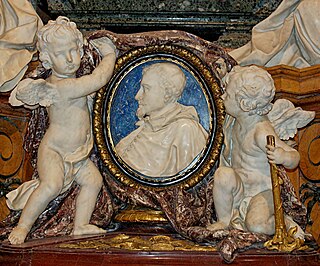
Ludovico Ludovisi was an Italian cardinal and statesman of the Roman Catholic Church. He was an art connoisseur who formed a famous collection of antiquities, housed at the Villa Ludovisi in Rome.

The Archdiocese of Bologna is a Latin Church ecclesiastical territory or archdiocese of the Catholic Church in Northern Italy. The cathedra is in the cathedral church of San Pietro, Bologna. The current archbishop is Cardinal Matteo Zuppi, who was installed in 2015.

The Boncompagni is a princely family of the Italian nobility who settled in Bologna around the 14th century, but which was probably originally from Umbria.

The Simonetti family is an Italian noble family with origins in Tuscany. During the 12th Century different branches in Florence, Terni, Lucca, Pistoia and Pescia developed. Other famous branches of this family were established in Jesi, Palermo, Milan and Bologna.
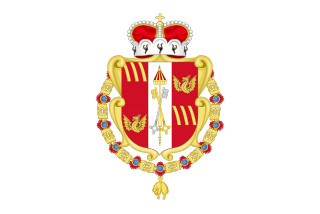
The Lordship of Piombino, and after 1594 the Principality of Piombino, was a small state on the Italian peninsula centred on the city of Piombino and including part of the island of Elba. It existed from 1399 to 1805, when it was merged into the Principality of Lucca and Piombino. In 1815 it was absorbed into the Grand Duchy of Tuscany.
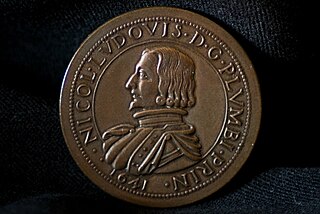
Niccolò I Ludovisi was Prince of Piombino from 1634 until his death, along his military and diplomatic career he was known and recorded in historical documents as Commander Niccolò da Candia, for his engagement in the Venetian colony of Crete, the Duchy of Candia

A cardinal-nephew was a cardinal elevated by a pope who was that cardinal's relative. The practice of creating cardinal-nephews originated in the Middle Ages, and reached its apex during the 16th and 17th centuries. The last cardinal-nephew was named in 1689 and the practice was abolished in 1692. The word nepotism originally referred specifically to this practice, when it appeared in the English language about 1669. From the middle of the Avignon Papacy (1309–1377) until Pope Innocent XII's anti-nepotism bull, Romanum decet pontificem (1692), a pope without a cardinal-nephew was the exception to the rule. Every Renaissance pope who created cardinals appointed a relative to the College of Cardinals, and the nephew was the most common choice, although one of Alexander VI's creations was his own son.

A crown-cardinal was a cardinal protector of a Roman Catholic nation, nominated or funded by a Catholic monarch to serve as their representative within the College of Cardinals and, on occasion, to exercise the right claimed by some monarchs to veto a candidate for election to the papacy. More generally, the term may refer to any cardinal significant as a secular statesman or elevated at the request of a monarch.

The House of Ruspoli is historically one of the great aristocratic families of Rome, but is originally from Florence. Following World War II and the fall of Fascism, the newly established Italian Republic officially abolished titles and hereditary honours in its 1946 Constitution, with the exception of the papal nobility of Rome, as those titles had been created by papal authority.

Olimpia Aldobrandini was a member of the Aldobrandini family of Rome, and the sole heiress to the family fortune.
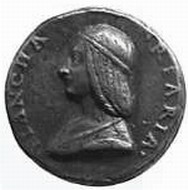
Bianca Riario was an Italian noblewoman and regent, Marchioness of San Secondo by marriage to Troilo I de' Rossi, and regent of the marquisate and county of San Secondo for her son Pier Maria during his minority between 1521 and 1522. She was the eldest child and only daughter of Caterina Sforza by the latter's first husband, Girolamo Riario, a nephew of Pope Sixtus IV.

The 1585 papal conclave, convoked after the death of Pope Gregory XIII, elected Cardinal Felice Peretti Montalto (O.F.M.Conv), who took the name Sixtus V. Forty-two of the sixty cardinals participated in the conclave. The absence of thirty percent of the cardinalate makes this conclave one of the most sparsely attended in the history of the modern Roman Catholic Church. Fourteen of Gregory XIII's thirty cardinals failed to attend, a startlingly high number.
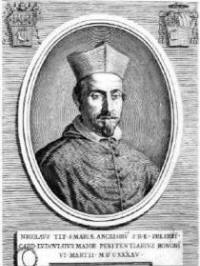
Niccolò Albergati-Ludovisi was an Italian Catholic Cardinal and Archbishop of Bologna.
Orazio Ludovisi (1561–1624) was an Italian nobleman, military commander and patrician of Bologna. During his brother's reign as Pope Gregory XV, he became Commander of the Papal Armies and Duke of Fiano and Zagarolo.

Giovanni Battista Agucchi was an Italian churchman, Papal diplomat and writer on art theory. He was the nephew and brother of cardinals, and might have been one himself if he had lived longer. He served as secretary to the Papal Secretary of State, then the Pope himself, on whose death Agucchi was made a titular bishop and appointed as nuncio to Venice. He was an important figure in Roman art circles when he was in the city, promoting fellow-Bolognese artists, and was close to Domenichino in particular. As an art theorist he was rediscovered in the 20th century as having first expressed many of the views better known from the writings of Gian Pietro Bellori a generation later. He was also an amateur astronomer who corresponded with Galileo.

Noli me tangere is a c. 1525 painting by Correggio of the subject noli me tangere, depicting Jesus and Mary Magdalene shortly after the resurrection.



















